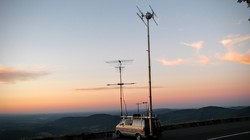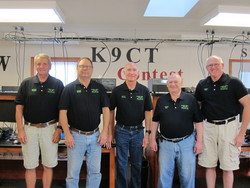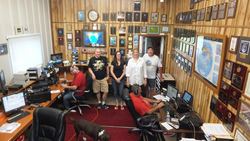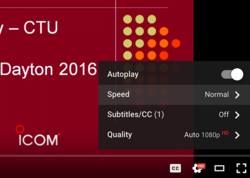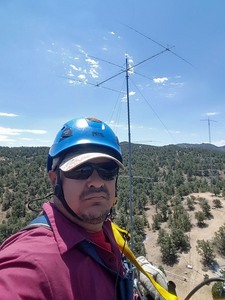 July 13, 2016 Editor: Paul Bourque, N1SFE | ||||||
IN THIS ISSUE
In the upcoming weekend, the NAQP RTTY will have a lot of activity. With a 12-hour period, and 100 W power limitation, it's a recipe for a bunch of contacts, and an opportunity to try running or putting together a multi-op. NAQP has a multi-two category, and with the propagation we've had recently it may be possible to be on all of the bands that are open, simultaneously. Charly, HS0HCW, has obtained special permission from the Thailand authorities to operate on six meters for the upcoming contest only. Contact him to suggest when there may be a path to HS from your location, using CW, SSB, or RTTY. BUSTED QSOS QRU Complete information for all contests follows the Conversation section July 14 July 15 July 16
July 17 July 18 July 20 July 21 July 22 July 23 July 27 Doug, KR2Q, has been named Director of the CQ WW DX Contest. Doug is no stranger to the workings of the contest, having been on CQWW Contest Committee since 1979. He is well positioned to consider all of the contest constituencies, having operated at one time or another in all entry categories. Congratulations, Doug!
Andy, K1RA, compiled an exhaustive report on the Grid Pirates K8GP/R rover operation that took place in the 2016 ARRL June VHF Contest. Terry, W8ZN, and Andy, K1RA, visited five grids, K8GP claiming 838 contacts. Their web report covers their preparation and operation in detail, including pictures, video and audio of some of the memorable DX contacts, as well as a post-contest analysis. (Rich, K1HTV) You've likely heard that Amateur Electronic Supply is closing all operations as July 28, after 59 years in business. On July 12, Ham Radio Outlet announced that they have concluded successful discussions to hire a number of AES personnel to staff HRO locations, and furthermore will remodel and reopen the largest North American retail amateur radio showroom in Milwaukee in August, 2016. Current AES phone numbers and web addresses will be handled by HRO after July 28. Something to contemplate while CQing into a closed band: Researchers think that fiddler crabs attract mates by generating vibrations akin to sending Morse code. The characteristics of their code sending can indicate their size and stamina. (Brian, K1BRF) Tomahhhhhto, Tomayyyyto, Cabrilloe, Cabreeyo. Just what is the pronunciation of that format for our contest log submissions? This is directly from Trey Garlough, N5KO: "Juan Rodríguez Cabrillo (João Rodrigues Cabrilho) is said to be the first European to navigate the coast of modern day California. Both the Spanish and the Portuguese claim him, so there is no one single correct answer to this question. Based on usage that I am exposed to both inside and outside of ham radio, kuh-BREE-yo wins by a 10-to-1 margin, or more, over other variations. Not definitive, but hopefully 'good enough' for your purposes. 73!" The World Wide Radio Operator Foundation has re-uploaded the webinar "When Giants First Walked the Bands," which is a look back by Doug, KR2Q, of CQWW contest multi-multi operations from 1959 to 1986. The 2016 Dayton Contest University videos and slides are now available on the Contest University website, along with some recently posted videos from 2015. The 2016 content may be choppy in some spots -- there was an issue in recording them. The Contest Dinner website has been updated to reflect past speakers and programs, as well as the Contest Hall of Fame. Planning ahead? The Contest Super Suite website has been updated to reflect the dates for 2017. Also hot out of Dayton are the Spurious Emissions Band 2016 videos. You may have your own bootlegs on your cellphone, but Bob, N6TV, was plugged into the soundboard.
Did you work W1AW/9 in IARU last weekend? W1AW/9 was comprised of the phone operation at WB9Z/NV9L, with CW at K9CT. In the IARU contest, headquarters stations are permitted one transmitted signal per band mode, meaning that it's possible to field multi-multi efforts on each mode. Headquarters stations must be in the same zone, so there's flexibility as to where they're deployed. W1AW/9 probably didn't have much inter-mode interference on any band, with about 100 miles of separation between the two operating locations. Both stations live-posted their scores to cqcontest.net, to goad each other to higher scores during the 24-hour period.
The phone station also livestreamed to Facebook and Periscope. According to Craig, K9CT, "The CW team operated on as many bands as there were open using one transmitter per band. However, there were times where 20 and 40 had many callers and we would change to use an assist station on each band with a transmit interlock. Then we could work multipliers and interleave other stations S&P while the other was running." The full results article for the ARRL January VHF Contest has been posted to the ARRL website. The number of logs submitted was about the same as last year, with the Mt. Airy VHF Radio Club having the highest number of submitted logs in the Affiliated Club Competition. Seventy logs were attributed to their members. Following the 2015 ARRL 10 Meter Contest, the Medium Category Club Competition was reviewed by the ARRL Contest Branch and adjustments based on member eligibility were made to several club totals. The updated Full Results has been posted to the ARRL website. This is a good time to remind everyone that Club Competition rules require clubs to meet specific criteria and provide certain information for each contest. These are defined in section 8 of the General Rules for All ARRL Contests. For example,
Please help your club leadership ensure that membership rosters are current -- including station locations -- and that the information is submitted in a timely fashion. As a matter of fairness to all participating clubs, the ARRL Contest Branch will begin working more closely with clubs to help them meet the rules of the Affiliated Club Competition. OPERATING TIP
Speed Watching Webinars When watching contest webinars or other video, you can usually speed watch by increasing the video playback speed. This can be a great way to do more viewing in less time -- a rate enhancer for sure! The option for increasing the video speed is generally located under the video settings options.
Tom, K5RC, has been orchestrating the construction and installation of new 80 meter beams at the Comstock Memorial Station, W7RN. It is a big, big project. Some details: The 80 meter beam antenna sports 91-foot elements, weighs 600 pounds, and has a 75 foot boom. Force 12 assembled the elements. A 200-foot crane was used to place the antennas onto the monopoles. Many people have been involved in this project, and on installation day, the crew consisted of K7NV, K6NV, KH2TJ, XE2K, K6NA, K6DGW, K5XI, and of course K5RC. Tom has photos on the W7RN website, and HD drone video was captured by AA7XT. You can get a sense of the size of the antenna in this video of the tips being installed. Hector, XE2K, had the task of affixing the antenna to the tower, and he's pictured at the top in the video. He also has an album of photos from the event. Elektor has updated its 2007 SDR receiver in the new form of an Arduino shield. The claimed range is from 150 KHz to 160 MHz. A video has been posted of the board in action, used with SDR-Sharp, decoding SSB and CW signals on 40 meters. It appears the Arduino assumes the role of the USB interface in the original design, and that I-Q outputs are still processed by a PC. In the January VHF Contest results, letters were used to denote the band capabilities of each station. The "P" designator is for light communications. The Internet of Things (IOT) Industry is now considering using light instead of RF for communications for data transmission between devices to avoid RF congestion. Larry, N6NC, suggests a method for using an antenna analyzer to determine the resonant frequency of an antenna trap. As a parallel L-C circuit, he found inductive coupling to be necessary: "Wind 8 turns of #14 AWG wire at one wire diameter spacing around a 3/8" to 1/2" diameter tube or dowel. Solder the coil to a PL-259 or BNC connector, and cover it with heat shrink tubing. When plugged into an analyzer, and inserted into the trap, the analyzer will act as a grid dip meter using the analyzer's SWR meter." Dave, KG0ZZ, has a YouTube video illustrating how to perform this measurement. Radiosport GO When talking about growing radio contesting and engaging youth, computer games are often mentioned as having the mindshare that we wish our hobby had. Over the last few days, you may have heard of Pokémon GO, a new game that is a variation of an old card collecting game that has rapidly captured the interest of gamers of every age. It's a big deal, and getting bigger. From July 5th to July 8th, the percentage of the 90+ million Android phone users in the US playing this game went from zero to five percent. In just four days. While we were participating in the IARU contest over the weekend, the game gained hundreds of thousands of users. Its daily usage is already approaching that of Twitter. It's an opportunity to watch a phenomenon happening right in front of us. To play, you must install the application on your smartphone. The application doesn't come with instructions or have any manuals. It's free to play. You have to either experiment with the application to figure it out, or find a mentor who has used it before. The premise is that you start with nothing, and advance in the game by collecting, developing, or winning Pokémon characters, which you can find by walking around outdoors and consulting the game application. What makes this game so appealing? One of Pokémon GO's innovations is that the Pokémon world is an overlay to our real world, with your phone showing you Pokémon that exist at particular places. You can visit new places to find particularly rare Pokémon. Another innovation is, that travelling at human-powered speeds by walking or biking in the physical world can reward the player with additional Pokémon opportunities. Once you have gained experience, you can also join a team or battle other players in particular places to achieve higher status and more Pokémon. Pokémon GO has recaptured the interest of many previous Pokémon players who thought themselves too old to be playing Pokémon. Anecdotal information indicates that nostalgia for past Pokémon fun, combined with the perceived virtuosity of walking or running to find characters makes it okay to play again as an adult. Of course, there are already reports of people cheating by driving in cars, flying drones, or using other techniques that are viewed as unethical. Aspects of the game have analogues in our hobby -- we generally start with no experience, and then learn by doing, sometimes with the help of a mentor. We might always be on the quest for our next DX entity, or that next multiplier. We develop skills that allow us to best other players in pileups or in contests. We can compete by travelling to particular locations that give us an advantage, like grids, mountaintops, or rare multipliers. We can compete singly, but we can also team to achieve. Also similar -- the original Pokémon was viewed as "moribund" until the new GO version appeared. Pokémon has reinvented itself through use of technology and modern engagement metaphors. Pokémon is not just a card game anymore. Some new players will never touch a card. Radio contesters have continuously drawn upon new technology and techniques to compete more effectively. That contest sponsors in general don't offer modern features like on-demand contests, instantaneous and continuous scoring, and faster turnaround of contest results makes us appear quaint. But will it still be radio contesting if players of the future don't have to physically touch a radio? That's all for this time. Remember to send contesting related stories, flea market pictures, book reviews, tips, techniques, press releases, errata, schematics, club information, pictures, stories, blog links, and predictions to contest-update@arrl.org. 73, Brian N9ADG 14 Jul - 27 Jul 2016 An expanded, downloadable version of QST's Contest Corral in PDF format is available. Check the sponsor's website for information on operating time restrictions and other instructions. HF CONTESTS CWops Mini-CWT Test, Jul 14, 0300z to Jul 14, 0400z; CW; Bands: 160, 80, 40, 20, 15, 10m; Member: Name + Member No., non-Member: Name + (state/province/country); Logs due: July 16. VHF+ CONTESTS CQ Worldwide VHF Contest, Jul 16, 1800z to Jul 17, 2100z; Any Mode; Bands: 6, 2m; 4-character grid square; Logs due: July 31. July 15, 2016 July 16, 2016 July 17, 2016 July 18, 2016 July 19, 2016 July 20, 2016 July 21, 2016 July 25, 2016 July 26, 2016 ARRL Information Click here to advertise in this newsletter, space subject to availability. Your One-Stop Resource for Amateur Radio News and Information ARRL membership includes QST, Amateur Radio's most popular and informative journal, delivered to your mailbox each month. Subscribe to NCJ - the National Contest Journal. Published bimonthly, features articles by top contesters, letters, hints, statistics, scores, NA Sprint and QSO Parties. Subscribe to QEX - A Forum for Communications Experimenters. Published bimonthly, features technical articles, construction projects, columns and other items of interest to radio amateurs and communications professionals. Free of charge to ARRL members: Subscribe to The ARRL Letter (weekly digest of news and information), the ARES E-Letter (monthly public service and emergency communications news), Division and Section news -- and much more! ARRL offers a wide array of products to enhance your enjoyment of Amateur Radio. Visit the site often for new publications, specials and sales. Donate to the fund of your choice -- support programs not funded by member dues! Reprint permission can be obtained by sending email to permission@arrl.org with a description of the material and the reprint publication. ACKNOWLEDGMENTS ARRL Contest Update wishes to acknowledge information from WA7BNM's Contest Calendar and SM3CER's Contest Calendar. | ||||||
